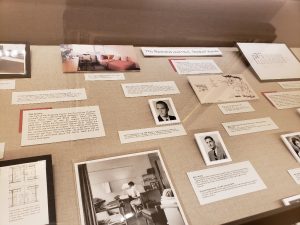by Lindsay Olsen
All across the Cambridge campus from February to July, Harvard University is  commemorating the birth of Bauhaus, the modernist school of art founded by German designer Walter Gropius in 1919. Events are on the calendar showcasing some of the school’s most creative affiliates, whose material is housed at the Harvard Art Museums, Harvard Film Archives, and Houghton Library. But it may come as a surprise that Bauhaus’s deepest connections are to Harvard Law School, which became home to the campus’s first example of modern architecture.
commemorating the birth of Bauhaus, the modernist school of art founded by German designer Walter Gropius in 1919. Events are on the calendar showcasing some of the school’s most creative affiliates, whose material is housed at the Harvard Art Museums, Harvard Film Archives, and Houghton Library. But it may come as a surprise that Bauhaus’s deepest connections are to Harvard Law School, which became home to the campus’s first example of modern architecture.
In 1948, HLS Dean Erwin Griswold commissioned Gropius, then a professor at the School of Art and Design, to build a $1.5 million student residence hall and common area in his signature utilitarian style, featuring heavy concrete and exposed support beams. The structure was christened Harkness Commons, and provided communal facilities that HLS was sorely lacking. Since the building is still in use today as the Caspersen Student Center, HLS wanted to take advantage of the centennial to share a little history about the spaces in which their students live and work every day.
On February 4, the Harvard Law Library Historical & Special Collections opened “Creating Community: Harvard Law School and the Bauhaus” in the Caspersen Room, the library building’s grand reception suite. Exhibit promotion kicked off on March 15 with a special edition of “Fridays @ Four,” a regular social event series hosted by the Human Resources department. Although Caspersen’s ornate décor gives off a strong “do not touch” vibe (the rare book collection lining the walls lives behind a thick sheet of glass), guests were invited to mingle freely with cocktails among a full spread of hors d’oeuvres. It wasn’t long before students and staff poured in, happily chatting and munching on chicken skewers while perusing four traditional display cases containing the photographic history of the modern art movement and the origins of Bauhaus at Harvard.
Of particular interest to attendees was the “Student Voices” display, featuring images from the archives of students, faculty, and Gropius’s team interacting during the planning process, as well as documentation of the overwhelming student input Harvard received about the project. Archival issues of the HLS publication, the Bulletin, pointed to the delay in allowing women to integrate into the space. Other exhibit cards blended historical reactions to the style of the building with present-day quotes from some of the former students who occupied the 364 starkly-decorated dormitories – most were humorously negative.
Statements from alums Elizabeth Papp Kamali and Arthur Greenbaum draw attention to the Joan Miró mural commissioned by Gropius to occupy a large space within the student center dining facility, unbeknownst to many who visit. Other artistic details remain hidden in plain sight, including brick reliefs by Josef Albers, glasswork by Herbert Bayer, and a wood sculpture by Hans Arp. Based on the minimal student reactions to the art over the last few decades, curators have guessed that many of the pieces have “faded into the background.” The “Creating Community” webpage states that, among other things, the exhibit will “[help] students get reacquainted with the art around them.”
Curated by HSC Manager Karen Beck and Public Services & Visual Collections Administrator Lesley Schoenfeld, “Creating Community: Harvard Law School and the Bauhaus” remains on view every day from 9:00am-5:00pm in the Caspersen Room through July 31, 2019. For those outside the Boston-Cambridge area, a truncated version of the exhibit has been made available online.
